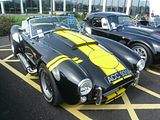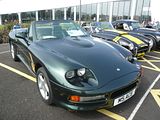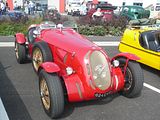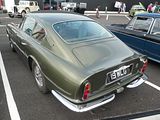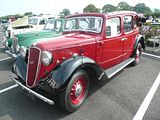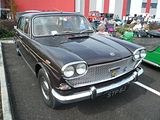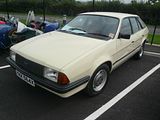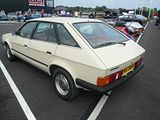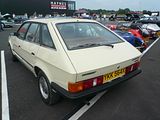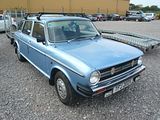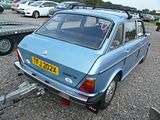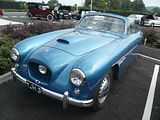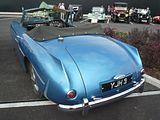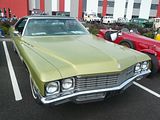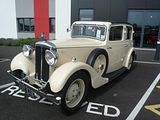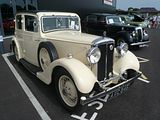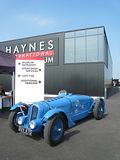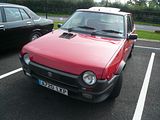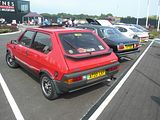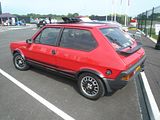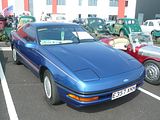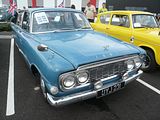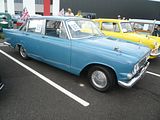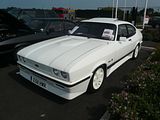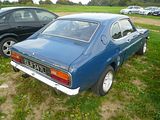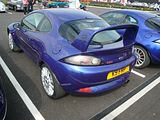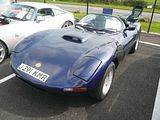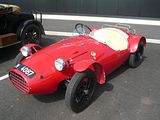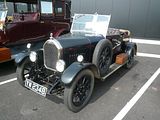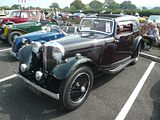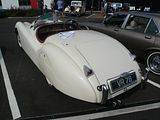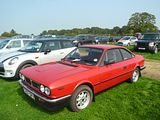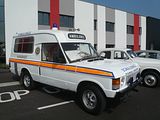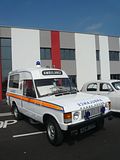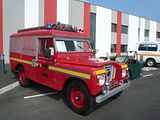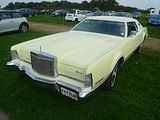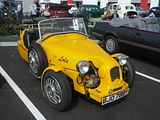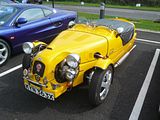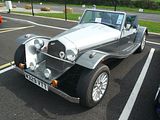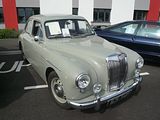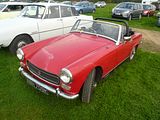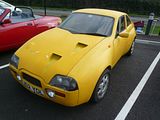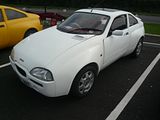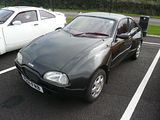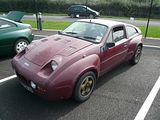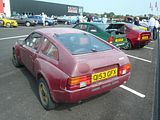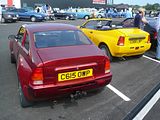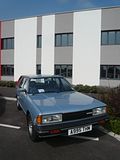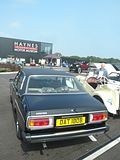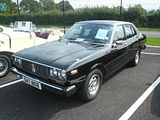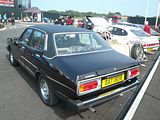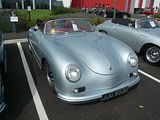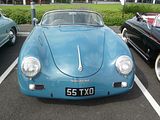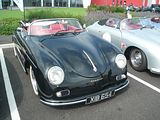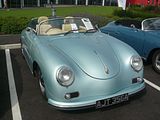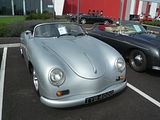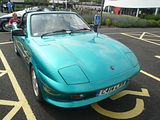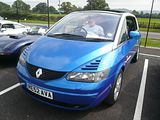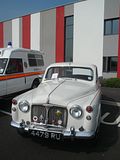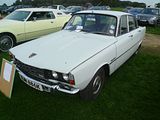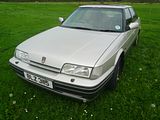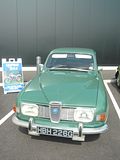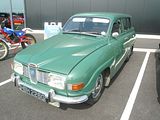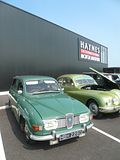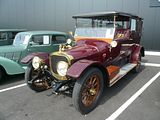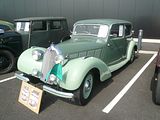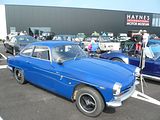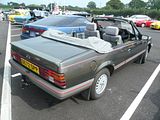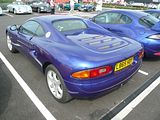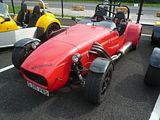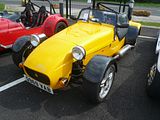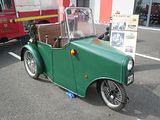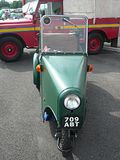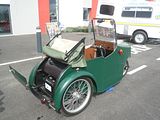Like most motor museums, and a good few other venues besides, the Haynes Museum, located at Sparkford, in the wilds of rural Somerset, runs an events program throughout the year to act as further encouragement to get people to come and visit. For several years now, the beginning of September sees on event called “Rare Breeds”, and the idea is to mount a display of cars either which were always rare, as few were ever sold, or which have become so because the survival rate is very low. What results, is unsurprisingly, an extremely eclectic mix of cars that you recognise and ones that you don’t. I’ve been a couple of times in recent years, and have always enjoyed this very laid back, finding some machines that I have never seen before, as well as others which you are not that likely to come across at another event. There was both a nice space in my calendar and the prospect of a lovely sunny day, so I set off down the A37, through Shepton Mallet, Castle Cary and on to Sparkford, to take this event, and also to get my first glimpse of the recently remodelled museum. Time pressures on my diary meant that I did not go in the museum, but I can certainly tell you that from the outside this is a very striking looking building indeed now, whereas what was there before just looked like rather utilitarian buildings (which is what they were). It was the cars outside that I had come to see, and what a varied mix they were:
AC
A big showing of “AC” models, most of which were Cobra replicas.
Also present was this Brooklands, a brave attempt at a new Sports/GT that promised much but which failed to deliver, especially in the quality of build, but also with dynamics which reflected the limited funds available to develop it.
ALFA ROMEO
David Roots brought along his eye-catching Alfa Special, and, as always, it was drawing the crowds, most of whom looked slightly puzzled in trying to decide exactly what it was. His information sheet had clearly dried out from the soaking it received at Castle Combe earlier in the year, so, when he was not around to answer questions in person, there were some facts that people could read up. An Alfa engine sits in a modified Austin Healey chassis, and it is clothed with a bespoke body that recalls the style of the 1938 Alfa 8C, I was delighted to learn later that David was awarded a prize for a car which best epitomised the “spirit of the event”, which was duly presented to him by museum founder John Haynes OBE.
ASTON MARTIN
The very desirable DB6.
AUSTIN
1930s Austins were all named after places in the UK, so this 12/4 was also called the Ascot. Dating from 1937, this is a splendid upper medium sized car that would have appealed to someone who could note quite afford a Rover, but who was of moderate means and could do better than the 8s and 10s that achieved far greater sales.
This magnificent 3 Litre was at this event last year, too. Austin’s enlarged version of the ADO17 “Land Crab” was not a success. A trouble birth following a reveal in 1967 meant that sales did not get underway til well into 1968, and by 1970 it was all over, though it took a while to sell the last cars. Fewer than 8000 were made. I think it looks better than the ADO17, and the six cylinder engine gave it a sort of effortless, if not rapid performance, but the market wanted something more dynamic, favouring large
Fords and Vauxhalls, as well as the slightly smaller Rover and Triumph 2000.
The Ambassador had a short life, of just 2 years, and by the time BL had added the hatchback that they should have put on the Princess from Day One back in 1975, it was an old (but spacious) car, competing against the new FWD Cavalier, which knocked the proverbial socks off it in all regards apart from roominess. This one, in period Rattan Beige, is a well looked after 2.0 HLS model.
Parked up round the back, was this Series 2 Maxi, a rare car indeed, as very few of this extremely roomy but sadly underdeveloped mid sized family car have survived.
BRISTOL
The products from Filton, Bristol, are not exactly common, but when you do see one, it is more likely to be one of the early 401 – 403 series cars than the later offerings. With their aluminium bodies, and the fact that the works was very happy to keep repairing older models long after most manufacturers would have given up, survival rates of these cars is quite high. This is the later 403 model.
The 405 was produced as a 4 door saloon (the only such 4 door Bristol have ever made) and an open topped car like this one.
BUICK
A giant of a car. this is a 1971 leSabre Coupe. Back in the day, huge 2 door Coupe models like this were very popular and every manufacturer had them in their range. They’ve all long since gone, replaced by an endless array of SUVs and Crossovers.
DAIMLER
I was chatting to the owner of this 1951 Consort, and he apologised for bringing it. He said it was because the 1938 Lanchester he had planned to bring had sprung an oil leak that morning and was not driveable. I told him that was really not a bad substitute. This particular car has only covered 46,000 miles from new, and has never been restored. It really did no look like it was over 60 years old.
Parked up along side it was a 1935 Daimler 15 Mulliner Sports Saloon. This car was also shown at the recent Classics at the Castle event in Sherborne, but it was nice to get a second look at a very splendid motor car.
DELAHAYE
The ex Rob Walker Delahaye 135 from 1936, which normally lives inside the museum, was brought into the open, and was the star turn posted at the entrance to the show, driven by his son, Robbie Walker. This is a splendid machine, with plenty of competition history behind it. In 1937, in the hands of Prince Bira of Siam, the car won the 12 hour sports car race at Donnington Park.
FIAT
Late arrival, and one of the first to depart was this splendid Strada 105TC.
FORD
Think of a rare Ford…….. and you probably would not come up with the Probe. So that proves that it is rare, because it probably does not even register in your brain until you are reminded of it. The second generation car was sold in the UK, as a sort of rival to the Calibra and a follow on to the much-missed Capri, but it did not really capture the public’s imagination, and sales were disappointing. The first generation car that was also present remained a US market car, and I drove a couple of these on my first ever trip to America, taking one of them around much of California, and quite liking it (at the time). The Probe had been planned as a replacement for the Mustang, but in the end, Ford kept their much loved and long-established car in the range and the Probe, based on a lot of Mazda componentry, was an addition to their line-up.
Better known, but also rare is the Mark 3 Zephyr and Zodiac range. Sold from 1962 to 1966, these large cars gained fame from their starring role in the tv police series “Z Cars”, but rust has claimed most of them, with the result that they are now far rarer than the earlier Mark 2 models. This Zodiac has been brought up to its present condition by a very proud owner who invited me to sit in it. There really is space for three adults across the front bench seat, and indeed if there were three of you there, it would stop you from sliding around on every bend, which you would with no seat belts and shiny flat vinyl seats. A real period piece and a car to be proud of.
Ford announced a venture with Newport Pagnell based coachbuilder Tickford in the autumn of 1983, creating the Tickford Capri, It used a turbocharged 2.8 Injection Cologne engine which developed 205 bhp, allowing it to reach 60 miles per hour in 6.7 seconds and 100 miles per hour in 13.4 seconds, topping out at 137 miles per hour. This version also featured a luxury interior with optional full leather retrim and Wilton carpeting and headlining, a large rear spoiler, a colour-coded front grille, deeper bumpers and ‘one off’ bodykit designed by Simon Saunders, later of KAT Designs and now designer of the Ariel Atom. Rear disc brakes were standard and there were numerous other suspension modifications. This model was essentially rebuilt by hand by Tickford at approximately 200 hours per car. One problem was the relative price difference to the standard Capri Injection, with the Tickford version costing twice as much. An idea like this would probably be a lot easier to sell now than it was then, where the price put too many people off, with fewer than 100 units being sold.
A Mark 1 Capri, in top of the range GXL spec was to be found in the car park.
There were a couple of racing Puma models on show.
GINETTA
G33
HAMBLIN
No, I did not know what this was either. It turns out to be a Hamblin de Luxe Special Cadet, and was made in 1958. A number of these were built on Austin 7 chassis, where the body had worn out but in “make-do and mend” post-war Britain, the chassis could have a new lease of life.
HUMBER
Most people think of Humber as a manufacturer of large luxury cars, as after the second World War that is indeed what they produced, but look back into the earlier years of this Coventry marque’s history, and you find a greater variety of cars. This one dates from 1928 and is a 9/28 3/3 Seater.
JAGUAR
This is an SS2, one of 152 elegant cars that were made by William Lyon’s company, this one dating from 1934, and one of just three such cars known to the SS Register now.
Elsewhere was a particularly lovely XK120, Lyon’s masterpiece of design which stunned the world when shown at the 1948 Earls Court motor show.
LANCIA
This lovely late model Beta Coupe Volumex was actually in the main car park rather than the event, though with Lancia and Beta models both very rare these days, it would surely have qualified to be in the event itself.
LAND-ROVER
4 of these Range Rovers were converted for emergency service use, by Herbert Lomas. Although built in 1971, this one did not get registered and enter service until January 1973, and it was initially used in Somerset to get to remote places that could not be reached by conventional emergency service vehicles.
Adapting Land Rover products was nothing new, and this is an earlier example, based on the familiar Land-Rover, with a Carmichael Redwing body on it.
LINCOLN
Another behemoth, to be found in the main car park, was this Lincoln Continental Mark IV. Just massive externally, but not particularly roomy inside, like most US “land yachts” of the time.
LOMAX
The Lomax is a fun car based on the Citroen 2CV. There tend to be a number of these appear at Prescott every year, but otherwise, not a car you see very often.
MARLIN
MG
A number of sporting MG saloons included the Y Type of the late 1940s and its replacement the Gerald Palmer styled ZA Magnette.
A slightly down at heel Midget was to be found in the main car park.
MIDAS
Lots of Midas models on show here. A kit car based on Mini and later on Metro underpinnings, Midas acquired the rights to the Mini Marcos design. “Production” continued a lot later than you might have thought, though the styling changes that were applied to house later Metro light units are of questionable taste.
NISSAN
Not one, nor yet two, but there Bluebirds here. The Estate model was present last year, and I’ve seen it a couple of other events. It is a rare survivor from the third generation of Bluebirds sold in the UK. Joining it was a 180B Saloon from the second generation. This is one of just 9 such models left in the UK, and has been carefully restored to its current immaculate state. Real period pieces, both of these, from the time when the Japanese were getting really established in the UK (and other) market.
Third car was one of the Sunderland built models which first arrived in 1986, seen here in hatchback form.
PORSCHE
There was a vast assembly of Porsche 356 like cars. Few, if any, were original, as almost all were more recent recreations such as the Chessil, but most seem, at a quick glance, to be quite well done, and they clearly bring a lot of fun to their owners.
QUANTUM
As kit cars go, this is one of the better resolved ones.
RENAULT
This Avantime is unusual in that the licence plate does not start H, suggesting it was bought retail rather than being a Renault UK registered car as most of them seem to be.
ROVER
In absolute terms, not that rare, the P4 Rover had a long production run from 1948 to 1964. This 6 cylinder 95 dates from the late 1950s.
In the main car park I came across this P6 model 3500S. Recently recovered from long term storage, the car is being fully restored and should be complete by the time of next year’s event, the information plaque with the car declared.
Also there was a car which is getting close to its 30th birthday, the Rover Sterling. Result of a joint venture with Honda, this car had the unenviable job of taking over from the much loved SD1 cars, and although objectively it was a “better” car, it never quite hit the same spot for many people.
SAAB
You don’t see many of the long-lived 96-based cars these days, and when you do it does tend to be a saloon, but the 95 Estate was quite popular when new. Most had hard lives and faded away a long time ago, but here is one that did not.
SUNBEAM
This very splendid Edwardian Motor car is a Sunbeam 16-20 Cabrio.
Rivalling the MG Magnette was the Sunbeam-Talbot 80 and later 90 model, a sports saloon that was also popular as a rally car, scoring notable success in the Monte Carlo Rally.
TALBOT-LAGO
French marque Talbot-Lago is best known for making very exclusive and expensive sports and luxury cars in the late 1930s. This T4 Minor Saloon, dating from 1938 was an attempt to offer a slightly cheaper model. Only 300 were produced, making it a rare car. A very elegant one, too.
TORNADO
I’ve seen this car at this event before. A Tornado Talisman, it was made in the early 1960s. Tornado was initially founded in 1957, offering a car called the Typhoon Sports. A kit car, its bespoke body fitted a Ford 8/10 chassis. About 400 of these were made over the next few years. In 1962, the company introduced the Talisman 2+2 coupe carrying an attractively styled fibreglass body on a more sophisticated tubular steel chassis with Ford 1340cc or 1500cc engines in various states of tune. This model was available either in component form or factory finished and at the time was praised for having lively performance combined with good ride and handling characteristics, and a high standard of finish. Cash-flow problems forced the company into liquidation in 1964 after 186 Talismans had been made.
Mark 2 Cavaliers are pretty rare these days, but the factory supplied convertibles are probably the rarest of the lot. Launched in 1985, a small number of these open topped versions of one of Britain’s favourite cars were sold.
VORTEX
A small specialist British manufacturer, Vortex Automotive, the name of the company since 2009 have been producing this elegant looking GTR for a number of years now, though this is only the second one of these I have ever seen. Effectively a kit car, but a very elegant one, most of these cars have Ford Mondeo componentry underneath.
WESTFIELD
WOLSELEY
57 of these Hornet Convertibles were produced by Crayford as prizes for a competition run by Heinz in 1966. As well as the bespoke soft top body, they came complete with a period picnic set. It is believed that 42 of them have survived.
Stablemate to the Hornet was the Wolseley 1100, a slightly posher version of the Austin and Morris 1100, Britain’s best selling car of the 1960s.
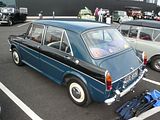
…. and FINALLY
Attracting almost more attention than anything else present, was this, an RA Harding Invalid Carriage. Looking at how vulnerable you would be on a thing this small, and with a Villiers 149cc engine, very slow, if you weren’t an invalid when you first got on it, I am sure you soon would be. A rare survivor of a Bath made device from the early 1950s, and the perfect manifestation of what this event is all about.
A expected, this turned out to be a very good day out. The sunny weather helped, but there was plenty to see, and much of it did live to the billing of the event of “Rare”. It was a shame that there was not time to take in the revamped museum, but with the closed season not too far away, there should be ample opportunity for an indoor attraction around an hour or so away. Thanks to a record attendance, the organisers have already announced a date to run this event in 2015: September 6th. I will be adding it to my schedule.



